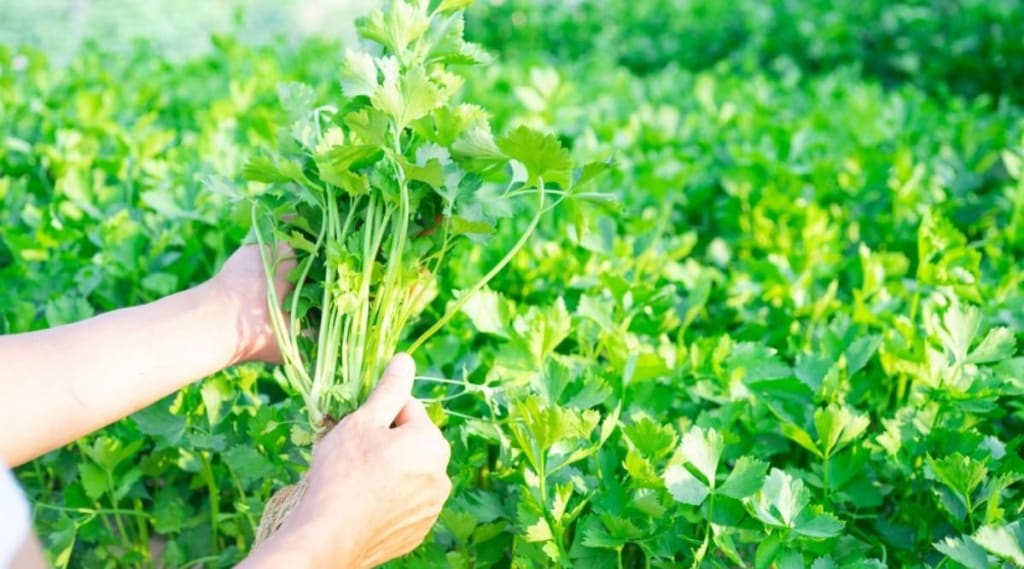Celery Farming in India with Necessary Information
Celery Farming

Celery is generally a leafy vegetable which you can grow from its stalk. It has become a household staple along with onion, carrot and potatoes. Celery thrives to a height of 12 - 16 inches and is composed of leaf top stalks arranged in a conical shape joined at a common base. Commercial cultivation of celery is confined to India. This vegetable's leaf stalks or petals are eaten raw as a salad and can sometimes be cooked as a vegetable.
Celery is mostly used as a flavouring agent in soups and juices. It is also grown for its seeds in temperate countries. You can also use the celery seeds in spices, condiments and medicines. The plant can reach 1m and belongs to the " Apiaceae " family and the " Apium " genus. You can grow the celery in a greenhouse, poly house also in the backyard. Some people can even grow it in pots and containers on the roof.
How to Start Celery Farming in India?
Starting commercial celery cultivation is easy and simple, just like growing other crops. Celery plants are very hardy and strong, requiring less care. When you start growing a celery plant, you need to know the various essential sections that would be useful for profitable celery cultivation. The tractor is the most prominent farm equipment with attachment for farming operations. You can choose the john deere 5310 because it is a renowned brand model which is suitable for celery farming, and you can choose any other famous tractor model.
Climate and Soil Requirement
You can grow the celery well in cool and humid climatic conditions. However, farmers cultivate it successfully in dry conditions by providing regular irrigation. The moderate and well-distributed annual rainfall will favour its growth during the initial vegetative phase. Celery is favourable for friable soil types and has the highest water holding capacity. Peat and muck soils are good for their cultivation. However, well-drained, friable, rich and deep soils are the best types for commercial farming. You can successfully grow the celery in the clay soil as well. Celery does not thrive best in soils where acidic conditions are more than a pH value of 5.6. Try to reduce the acidic conditions if the soils are more acidic.
Land Preparation and Planting Methods
You should plough the land thoroughly, and also should well-pulverise and level the field's topsoil. You can sow the celery seeds directly in the field with a good irrigation facility as seedlings in a nursery, and you can transplant them in the field. Celery seeds, which are fruits, take a long time to germinate and need to be sown in well-prepared beds. Seeds should be sown in nursery beds from July to September and need to be provided with partial shade and cool conditions. You should keep the seeds moist for a few days before sowing to help speed up germination.
About 300 to 450 grams of seed is required for one hectare. You should cover the seeds lightly, and after 4 to 8 weeks, shoots emerge and thin to a distance of about 1.2 cm. Farmers transplant the seedlings after about 2 months at a distance of 45 X 15 cm or 60 X 15 cm. They should not do the planting too deep.
Intercultural Operations
Generally, celery is a long duration crop; therefore, you should carry out proper weed control operations. Mulching is one of the best options to control weeds. You should carry light hoeing regularly, and remove lateral shoots. In addition, you should apply the Linnorm at the rate of 15 kg/ha to control celery plants' weed growth. You need too much blanching in celery farming to make crisp, reduce acrid flavours, and increase tenderness and good flavour.
(Blanching is generally a process of keeping out light from the leaf stalk, which checks the development of chlorophyll.)
Manures and Fertilisers
Usually, it takes a dosage of about 20 to 25 tonnes of well-rotted manure (F.M.Y). Inorganic fertilisers like 200 kg K 'N', 100 kg P2O5 and 150 kg K2O are required for one hectare of land.
Irrigation in Celery Farming
You require adequate frequent irrigation with good drainage for celery farming, and you should keep it away from waterlogging. It also needs irrigation after top dressing nitrogen application.
Harvesting and Yield
You can harvest the celery at various stages of plant growth, depending on the market demand. You can carry out harvesting after four to five months after sowing. First, you need to cut each plant just below the surface with a sharp knife. Then trim the plant and prepare for the market. The yield depends on the soil type, cultivar, farm management practices and agro-climatic conditions. You can obtain an average yield of about 25 to 30 tonnes/ha.
Need the Equipment
For better celery farming operation and productivity, you should do the cultivation in a modern way. The cultivation of celery required better tractors and implements. And farmers/users can choose the best tractor according to their budget. We recommend the Swaraj 855 tractor model. Also, you can find John Deere 5050d, Mahindra Yuvraj 215 NXT and any other tractor that fits your budget.
For further knowledge about celery farming in India, stay tuned with us.
About the Creator
Tractor Guru
Do you want to know which Popular Tractor Tyre is the most popular in India? We recommend that you go to TractorGuru.in because there are so many popular brands to choose from. CEAT Tyre, JK Tyre, and MRF Tyre
Enjoyed the story? Support the Creator.
Subscribe for free to receive all their stories in your feed. You could also pledge your support or give them a one-off tip, letting them know you appreciate their work.






Comments
There are no comments for this story
Be the first to respond and start the conversation.